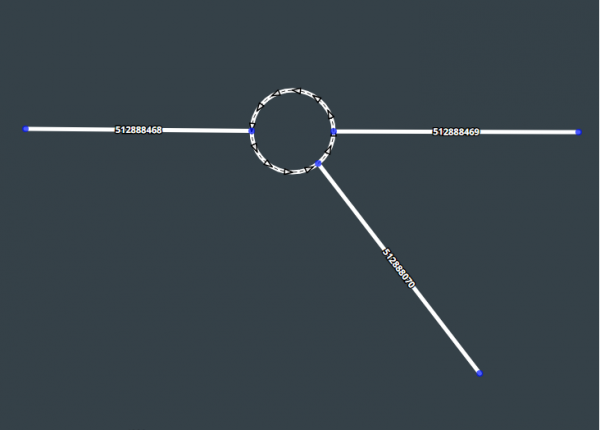When you edit, you are often creating and deleting segments and nodes, even when you don't realize it.
If you take a moment to select the segments and nodes and look at their IDs in the left pane, you can see what is happening.
- Every segment has a unique segment ID.
- There is a node at the end of each segment. Each node has a unique segment ID.
- If that node forms the junction between two or more segments, editors often call it a "junction node"
- If that node is only attached to one segment, editors often call it an "end node"
- If you select a node and move it, all attached segments ends will move with it.
- If a node has no segments attached to it, it will be deleted.
- If you select a segment and move one of its ends, it will leave the node (junction or end) behind
- If you select a segment, move one of its ends, and attach that end to a junction of 2 or more segments, or to the unattached end of another segment, that segment will now be attached to the node at the new location
- If you select a segment, move one of its ends, and leave that end unattached in the new location, a new node will be created at the unattached end of the segment.
- If you merge two segments by deleting the node between them, or by using the bridge button, the node and both segments are deleted and replaced by a new segment with a new segment ID
- If you cut a segment into two segments, the original segment is deleted. Two new segments are created and one new node joining them
- If a segment has one "free" end which is not joined to any other segments, there is still a node attached to the free end.
Here is what happened during an actual editing session.
Every segment is attached to two nodes - one node at each end of the segment.
|
At the junction, two segments are connected to the same node. There is exatly one node at a junction.
|
When a segment is highlighted and one end is dragged away from a node, a new node is automatically created on the segment that was just moved.
|
When a node is dragged and connected to another node, the "stationary" node (the one that didn't get dragged) is retained. The node that was moved is deleted.
|
When a segment is cut by dragging a node to a point somewhere in the middle two new segments are created. The dragged node used for cutting becomes the node for the new junction. When a segment is cut by dragging the segment end (without the formerly-attached node), a new node is created at the cut point.
|
A segment is disconnected from the junction and gains a new node at the end
|
Another segment is disconnected from the junction
|
Two segments are joined. The stationary node is retained as the node from the moving end of the other segment is deleted
|
If you select the junction of 2 segments and drag it to another node, both segments will have their ends dragged along with the junction
|
All the segments are now joined at one junction. The stationary node is retained. The node that was moved is deleted.
|
Replacing a junction with a roundabout preserves the segment IDs, but the junction node ID is lost. There is a new node where each of the segments joins the new roundabout
|









